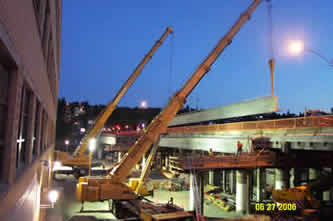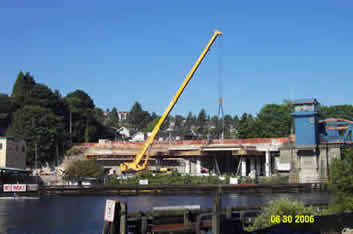May 2007 - When the City of Seattle recently made the decision to update some of its historic infrastructure, it called on Sicklesteel Cranes to do the job.
The Fremont Bridge, which originally opened on July 4, 1917, required seismic retrofitting and upgrading, including the replacement of the existing approaches. The work was no easy matter: As one of only six Lake Washington ship canal bridges linking the northern end of Seattle to downtown, the Fremont bridge, standing just 30 feet above the water, rises for marine traffic on an average of 35 times per day, making it one of the busiest bascule drawbridges in the world.
In explaining the choice of the Seattle, Washington based crane company for the demanding job, Meredith Daniels, Fremont Bridge Project Manager for Mowat Construction, explained, “Sicklesteel continues to lead the industry by providing experienced lift coordinators, talented and certified crane operators, professional engineering staff, and the broadest range of equipment available in the Pacific Northwest.”

Indeed, since the inception of CCO crane operator certification, Sicklesteel Cranes, Inc., Seattle, WA, under the leadership of company president, Thom Sicklesteel, has been a strong supporter of the program developed and administered by the National Commission for the Certification of Crane Operators (NCCCO). Sicklesteel operators began taking the CCO written examinations back in 1996. For the past two years, CCO certification has been a requirement for crane operators and mechanics alike.
Sicklesteel employs more than 80 employees who perform work in Washington, Oregon and Idaho. The company, which has been providing professional lifting assistance in the Pacific Northwest since 1937, offers lifting capabilities up to 650 tons through a broad range of equipment.

Due to the complexity of the Fremont Bridge project, and the tight clearances on both approaches, Sicklesteel provided a lift coordinator to assist the primary contractor on the project from the planning stages through the implementation of the lift plan. The development of the lift plan took into consideration the restricted access and crane sizing by manipulating the sequence to provide maximize utilization and minimize cost while keeping safety a priority and allowing the operation of the bridge to continue.
Sicklesteel drew on the lifting power of some of its larger hydraulic cranes to set the girders on the job that weighed in excess of over 190,000 pounds. Cranes used in the operation included a Demag AC 1600 650 ton, a Demag AC 1300 500 ton, a Demag AC 1020 450 ton, and a Demag 6155 280 ton crane, which provided both multiple and single crane lifts during this complex project and helped the company complete each phase ahead of schedule and under budget.
It’s typical of the leadership role that Thom Sicklesteel espouses that, in requiring CCO certification of his employees, he should become certified himself. “It’s only fair if our company safety plan requires our operators to be trained, tested and certified, then our supervisors, including myself, should participate as well,” he explains.
Sicklesteel is no stranger to that role. After the Kingdome crane accidents in 1995, Thom was an active participant in the development of the Washington Crane Safety Association and served as its Chairman. More recently he provided expert testimony in Washington State’s House of Representatives and Senate as the state’s new crane operator certification law was being written.